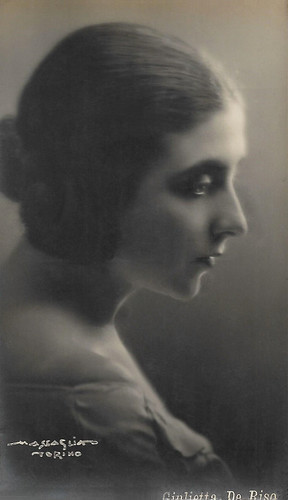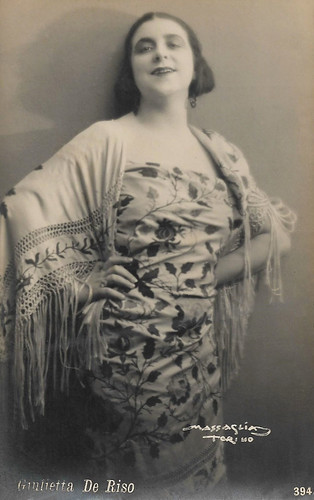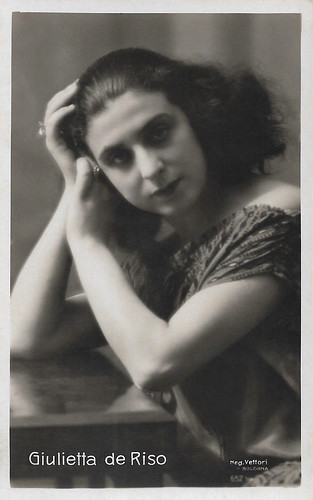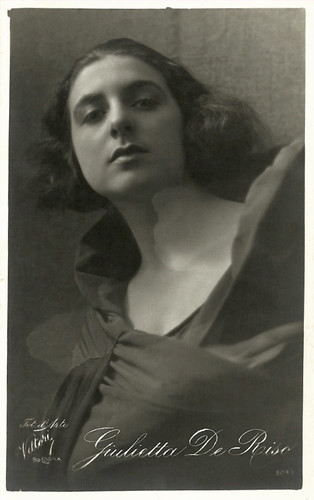
Italian postcard by Ballerini & Fratini, Firenze (Florence), no. 392. Photo: Massaglia, Torino (Turin).

Italian postcard by Ballerini & Fratini, Firenze (Florence). Photo: Massaglia, Torino (Turin).

Italian postcard by Ballerini & Fratini, Firenze (Florence), no. 394. Photo: Massaglia, Torino (Turin).
A bizarre plot by Gabriele D'Annunzio
Giulietta De Riso was born om 1898 in Smyrna, Ottoman Empire (now Izmir, Turkey). She was the elder sister of the screenwriter Arpad De Riso and a relative of the actors Alfonso, Camillo, and Giuseppe De Riso.
She made her debut as a film actress in 1911 at the age of thirteen with short films produced by Arturo Ambrosio for Ambrosio Film alongside Giuseppe De Riso. She mostly played supporting parts at Ambrosio.
From 1913, De Riso als acted in features at Ambrosio, among which the 1913 film Mater Dolorosa, starring Mary Cléo Tarlarini. In 1914-1915, Enrico Novelli, son of actor Ermete Novelli and using the pseudonym of Yambo, cast De Riso in several films such as L'eredità della laguna (1914) and Fiorenza mia! (1915).
In 1917 De Riso was one of the actors in the D'Annunzio adaptation La crociata degli innocenti (Alessandro Blasetti, Gino Rossetti, Alberto Traversa, 1917), also with Bianca Virginia Camagni and Luigi Serventi. This debut of Blasetti as film director, nowadays a lost film, has a bizarre plot scripted by Gabriele D'Annunzio, after his stage play.
During the Middle Ages, a shepherd (Guido Graziosi) is told by a leprose prostitute (Camagni) she can be healed by drinking drops of blood of an innocent. So, he slaughters his innocent sister (De Riso). A pilgrim (Serventi) resurrects the sister and heals the prostitute, who converts to Christianity. The pilgrim takes all along a children's crusade to Palestine. The voyage ends in a massive shipwreck and killing. The Italian film press thought the film too slow and static.

Italian postcard by SIF, no. 133.

Italian postcard by Neg. Vettori, Bologna, no. 16.
She never became a real star or diva
Giulietta De Riso's last silent film, Crevalcore (Romolo Bacchini, 1917), starring Italia Almirante Manzini. The press praised the film, in particular the adaptation of a popular and even awarded novel, and the performance of the two leads, Almirante and Gigi Armandis.
Until 1917, De Riso had acted in almost twenty short, medium-long and long films, but she never became a real star or diva. De Riso's regular co-actors were Mario Bonnard, Carlo Campogalliani, and Gigetta Morano.
In the 1920s De Riso concentrated on her stage performances. She was part of the company of Luigi Almirante, with Italia Almirante and Tullio Carminati.
In 1928 she founded her own company with Memo Benassi. During the sound era De Riso's film presence was sporadic; she only appeared in four films between 1934 and 1957. Her role as Isabella Pietramelara is relevant in the first sound version of Il cardinale Lambertini/Cardinal Lambertini (Parsifal Bassi, 1934), starring Ermete Zacconi.
In 1936 she recorded with Rodolfo De Angelis and Ernesto Ferrero the 78 rpm record 'È un tango', a three-part joking dialogue directed by Mario Consiglio. She also worked for the radio and in 1944 she was among the interpreters of the revue of Mario Amendola, 'Scandalo al collegio', with Erminio Macario.
Her final screen appearance was in the French-Italian film Mattino di primavera/Spring morning (Giacinto Solito, 1957).
Giulietta De Riso passed away in Roma (Rome), in 1988.

Italian postcard by Neg. Vettori, Bologna, no. 16.

Italian postcard by Neg. Vettori, Bologna, no. 652.

Italian postcard by Fot. d'Arte Vettori, Bologna, no. 3041.
Sources: Vittorio Martinelli (Il cinema muto italiano), Wikipedia (Italian), and IMDb.
No comments:
Post a Comment